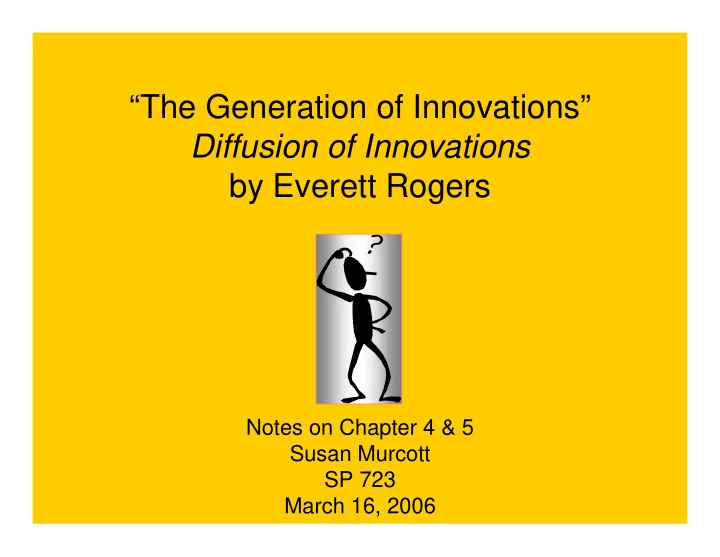

“The Generation of Innovations” Diffusion of Innovations by Everett Rogers Notes on Chapter 4 & 5 Susan Murcott SP 723 March 16, 2006
Innovation-Development Process - Definition • All decisions, activities, and their impacts that occur from recognition of a need or problem, through research, development and commercialization of an innovation, through diffusion and adoption of an innovation by users to its consequences.
What are the 6 Main Stages of the Innovation-Development Process?
6 Main Stages of the Innovation-Development Process 1) Needs/Problems 2) Research (basic and applied) 3) Development 4) Commercialization 5) Diffusion and Adoption 6) Consequences Time
Commercialization, Diffusion & Adoption and Consequences all occur after T 1 . S-shaped Diffusion Curve Commercialization, Diffusion and Adoption, Consequences Research and Development Activities to Produce an Innovation T o T 2 Time -------------------------- � Time ------------------------ � T 1
Who Develops Innovations?
Who Develops Innovations? • Science and engineering researchers • Policy-makers (e.g.seat belts) • Manufacturers • Lead Users
Development - Definition • Process of putting a new idea into a form that is expected to meet the needs of potential adopters. • Development means coming up with the chosen design and/or prototype that is “ready for manufacture”
A technology usually has 2 components: matter and energy or… • Hardware – the tool that embodies the technology as a material or physical object • Software – the information base for the tool
Technology Transfer (TT) – Defn. and Conventional View • Technology transfer is the application of information to use. • The conventional conception of TT is that it is a process through which the results of basic and applied research are put into use by “receptors.” This view implies that TT is a one-way process Also, technology is seen as mainly hardware .
The Design Process (standard textbook version) • Problem Definition • Idea Generation • Information Gathering • Concept Evaluation • Lab Research, Experimentation & Analysis • Detail Design • Fabrication • Testing & Evaluation (Lab and Field)
Technology Transfer – 2-Way Exchange (“Co-evolutionary”) Technology transfer is a communication process – a 2-way exchange
Co-Evolutionary Design for Development (an iterative process) 1. Problem Awareness through Partnership 10. Reiteration 2. Problem Co- / Reinvention Definition 9 Scale-up Co-evolutionary 3. I dea Co- Design 8. I mplementation Generation for Development 7. Pilot studies 4. Concept Co-Evaluation 6. Refined Design (Field and lab testing, 5. Field Experience, multiple sites, Fabrication, multiple countries) Experiment, Lab Work, Analysis
What are the 3 levels of Technology Transfer?
3 Levels of Technology Transfer • Knowledge – the receptor knows about the technology • Use – the receptor has put the technology into use in his or or organization. • Commercialization – the receptor has commercialized the technology into a product that is sold in the marketplace.
What is technical determinism? What is social determinism? (What do you believe?)
Technical Determinism • Belief that technology causes changes in society
Social Determinism • Belief that technology is shaped by social factors, a product of society o causes changes in society
The Generation of Innovations Chapter 5
What are the 5 Stages of the Innovation-Decision Process? Time
5 Stages of the Innovation-Decision Process 1) Knowledge 2) Persuasion 3) Decision 4) Implementation 5) Confirmation Time
In the US, in the “Knowledge Stage” what do you think comes first, 1. The Need? 2. The Awareness? In other words, do you think we in the US are active or passive in the process? (relates to “selective exposure”)
Can you think of an example where you have been influenced or have influenced someone to try an innovation in the “persuasion stage?” What about the decision stage?
Can you think of an example where you have been in the “implementation stage?” What about the confirmation stage?
What experience do you have with this innovation-decision process? e.g. Skype? e.g. ??? Time
What are the 3 Types of Innovation Knowledge?
3 Types of Innovation Knowledge • Awareness • “How to” • Principles
“preventive innovation?” What is a
“Preventive Innovations” • New idea users adopt to avoid possible occurrence of some unwanted event. • The unwanted event may or may not occur if the innovation is adopted • The rate of adopt of an of preventive innovations is slower than for non-preventive innovations •
What are some generalizations about early vs. late knowers of an innovation?
Early vs. late knowers of an innovation. Early knowers have: • More education; • Higher social status • More exposure to mass media • More exposure to interpersonal channels of communication; • More contact with change agents; • More social participation; • Are more cosmopolite (Is this true in your experience of innovations?)
Forecasting Model?” What the Bass
Sustainability of an innovation • Degree to which an innovation is continued over tie after a diffusion program ends
What is Reinvention? Do you have any experience of it?
Mass Media vs. Interpersonal Channels Generalization: Mass media channels are relatively more important at the knowledge stage , and interpersonal channels are relatively more important at the persuasion stage in the innovation-decision process.
Recommend
More recommend